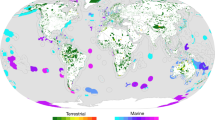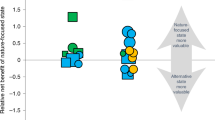Abstract
Protected areas vary enormously in their contribution to conserving biodiversity, and the inefficiency of protected area systems is widely acknowledged1,2,3. However, conservation plans focus overwhelmingly on adding new sites to current protected area estates4. Here we show that the conservation performance of a protected area system can be radically improved, without extra expenditure, by replacing a small number of protected areas with new ones that achieve more for conservation. Replacing the least cost-effective 1% of Australia’s 6,990 strictly protected areas could increase the number of vegetation types that have 15% or more of their original extent protected from 18 to 54, of a maximum possible of 58. Moreover, it increases markedly the area that can be protected, with no increase in overall spending. This new paradigm for protected area system expansion could yield huge improvements to global conservation at a time when competition for land is increasingly intense.
This is a preview of subscription content, access via your institution
Access options
Subscribe to this journal
Receive 51 print issues and online access
$199.00 per year
only $3.90 per issue
Buy this article
- Purchase on Springer Link
- Instant access to full article PDF
Prices may be subject to local taxes which are calculated during checkout


Similar content being viewed by others
References
Rodrigues, A. S. L. et al. Effectiveness of the global protected area network in representing species diversity. Nature 428, 640–643 (2004)
Wiersma, Y. F. & Nudds, T. D. Efficiency and effectiveness in representative reserve design in Canada: the contribution of existing protected areas. Biol. Conserv. 142, 1639–1646 (2009)
Ceballos, G. Conservation priorities for mammals in megadiverse Mexico: the efficiency of reserve networks. Ecol. Appl. 17, 569–578 (2007)
Scott, J. M. et al. Gap analysis: a geographic approach to protection of biological diversity. Wildl. Monogr. 123, 1–41 (1993)
World Database on Protected Areas. 〈http://www.wdpa.org/〉 (2009)
Ando, A., Camm, J., Polasky, S. & Solow, A. Species distributions, land values, and efficient conservation. Science 279, 2126–2128 (1998)
Mora, C. et al. Coral reefs and the global network of marine protected areas. Science 312, 1750–1751 (2006)
Jaffre, T., Bouchet, P. & Veillon, J.-M. Threatened plants of New Caledonia: is the system of protected areas adequate? Biodivers. Conserv. 7, 109–135 (1998)
Rodrigues, A. S. L. et al. Global gap analysis: priority regions for expanding the global protected-area network. Bioscience 54, 1092–1100 (2004)
Carwardine, J. et al. Cost-effective priorities for global mammal conservation. Proc. Natl Acad. Sci. USA 105, 11446–11450 (2008)
Underwood, E. C. et al. Expanding the global network of protected areas to save the imperiled Mediterranean biome. Conserv. Biol. 23, 43–52 (2009)
Naidoo, R. et al. Integrating economic costs into conservation planning. Trends Ecol. Evol. 21, 681–687 (2006)
Strange, N., Thorsen, B. J. & Bladt, J. Optimal reserve selection in a dynamic world. Biol. Conserv. 131, 33–41 (2006)
Department of the Environment, Water, Heritage and the Arts; Australian Government. Australia’s Strategy for the National Reserve System 2009–2030 〈http://www.environment.gov.au/parks/publications/nrs/nrsstrat.html〉 (2009)
Department of the Environment, Water, Heritage and the Arts; Australian Government. Collaborative Australia Protected Area Database 〈http://www.environment.gov.au/parks/nrs/science/capad/2006/index.html〉 (2009)
Stein, J. in Linking Rivers to Landscapes (eds Rutherford, I., Wiszniewski, I., Askey-Doran, M. & Glazik, R.) 448–552 (Department of Primary Industries, Water and Environment, 2005)
Roberts, C. M., Bohnsack, J. A., Gell, F., Hawkins, J. P. & Goodridge, R. Effects of marine reserves on adjacent fisheries. Science 294, 1920–1923 (2001)
Vane-Wright, R. I., Humphries, C. J. & Williams, P. H. What to protect?—Systematics and the agony of choice. Biol. Conserv. 55, 235–254 (1991)
Meir, E., Andelman, S. & Possingham, H. P. Does conservation planning matter in a dynamic and uncertain world? Ecol. Lett. 7, 615–622 (2004)
Vandergeest, P. Property rights in protected areas: obstacles to community involvement as a solution in Thailand. Environ. Conserv. 23, 259–268 (1996)
Dearden, P., Chettamart, S. & Emphandu, D. Protected areas and property rights in Thailand. Environ. Conserv. 25, 195–197 (1998)
Vandergeest, P. Reply: Protected areas and property rights in Thailand. Environ. Conserv. 26, 7–9 (1999)
Hardin, G. The tragedy of the commons. Science 162, 1243–1248 (1968)
Veit, P. G., Nshala, R., Ochieng' Odhiambo, M. & Manyindo, J. Protected Areas and Property Rights: Democratizing Eminent Domain in East Africa (World Resources Institute, 2008)
Child, K. Civil society in Uganda: the struggle to save the Mabira Forest Reserve. J. East. Afr. Stud. 3, 240–258 (2009)
Sussman, R. W., Green, G. M. & Sussman, L. K. Satellite imagery, human ecology, anthropology, and deforestation in Madagascar. Hum. Ecol. 22, 333–354 (1994)
Norton-Griffiths, M. & Southey, C. The opportunity costs of biodiversity conservation in Kenya. Ecol. Econ. 12, 125–139 (1995)
Emerton, L., Bishop, J. & Thomas, L. Sustainable Financing of Protected Areas: A Global Review of Challenges and Options (IUCN, 2006)
Acknowledgements
We thank J. Stein for providing subcatchment data, and L. Barr, C. Fuller, B. Kendall, T. Martin and H. Wilson for discussion. This work was funded by the Centre for Applied Environmental Decision Analysis, an Australian Commonwealth Environment Research Facility.
Author information
Authors and Affiliations
Contributions
All authors designed the research. E.M.-M., D.C.G. and R.A.F. performed the analysis, and R.A.F. wrote the manuscript. All authors discussed the results and commented on the manuscript.
Corresponding author
Ethics declarations
Competing interests
The authors declare no competing financial interests.
Supplementary information
Supplementary Information
This file contains Supplementary Figures S1-S3 with legends, Supplementary Methods and References. (PDF 167 kb)
PowerPoint slides
Rights and permissions
About this article
Cite this article
Fuller, R., McDonald-Madden, E., Wilson, K. et al. Replacing underperforming protected areas achieves better conservation outcomes. Nature 466, 365–367 (2010). https://doi.org/10.1038/nature09180
Received:
Accepted:
Published:
Issue Date:
DOI: https://doi.org/10.1038/nature09180
This article is cited by
-
Marine Protected Area Expansion and Country-Level Age-Standardized Adult Mortality
EcoHealth (2023)
-
Sociopolitical drivers and environmental outcomes of protected area downgrading and degazettement in Cambodia
Regional Environmental Change (2022)
-
A global analysis of the drivers of human pressure within protected areas at the national level
Sustainability Science (2020)
-
How to choose the best category for a protected area? A multicriteria analysis method based on ecosystem services conservation
Environmental Monitoring and Assessment (2020)
-
On the Barriers to Adaption to Less Water under Climate Change: Policy Choices in Mediterranean Countries
Water Resources Management (2018)
Comments
By submitting a comment you agree to abide by our Terms and Community Guidelines. If you find something abusive or that does not comply with our terms or guidelines please flag it as inappropriate.



